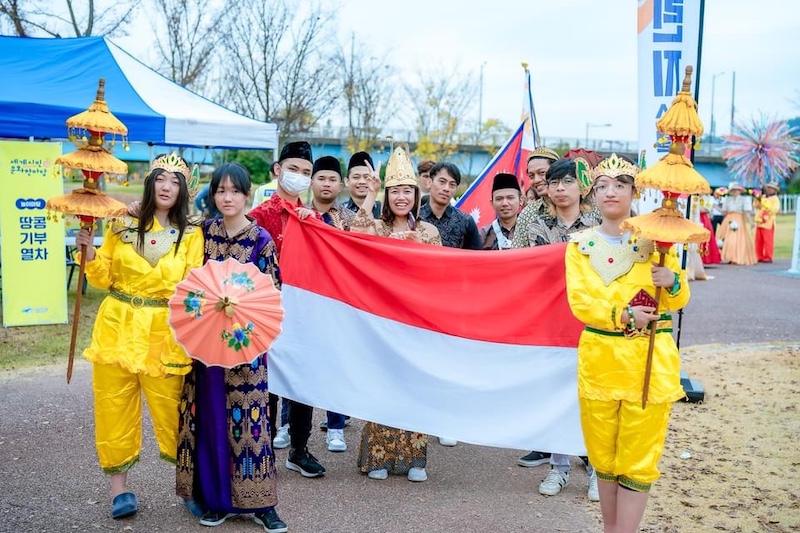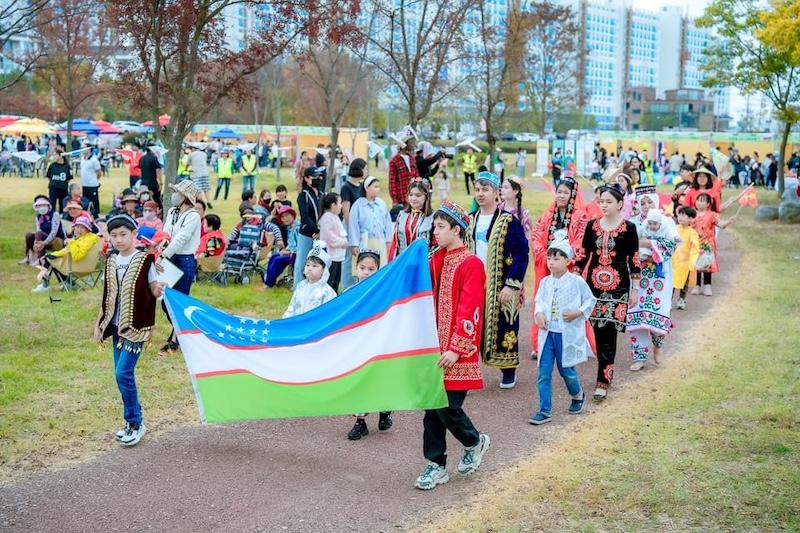Hosting the World: Gwangsan-gu’s Global Citizens Culture Festival
By Julien Laheurte
On the November 4 between 12–6 p.m., the Gwangsan-gu Global Citizens Culture Festival unfolded at Hwangryong Chinsu Park, in the vibrant heart of west Gwangju. Under the banner of “Meeting the World in Gwangsan,” this event provided a platform to delve into the rich tapestry of cultures comprising Gwangsan, the most multicultural district in Gwangju. The festival was collaboratively planned and organized by residents from 25 nationalities, with the support of the National Central Asian Cultural Center and Gwangju Cultural Foundation. With a twofold mission, it sought to recognize the residents of this district, whether Korean or non-Korean, as integral components of a “global world.” It did so by championing values of respect, exchange, and empathy for each other’s customs and traditions. Moreover, the festival marked the inauguration of the novel Foreign Residents and Multicultural Affairs Department. This milestone signifies Gwangsan’s commitment to providing systemic support and governance for the approximately 22,000 foreign residents and multicultural families living in Gwangsan-gu. The department’s responsibilities encompass comprehensive support plans for foreign residents, pioneering new public infrastructure development, steering the network of foreign residents organizations, and spearheading collaborative projects with foreign nations.
The festivities kicked-off with the musical theater production titled “Story in Asia,” a creation by the National Central Asian Culture Center. This performance harmonized the traditional pansori from Korea with content inspired by Asian folk tales from Myanmar and Indonesia. Following this captivating overture, an array of performances, as part of the “Our Neighborhood Fringe Festival” displayed a diverse range of shows, from mask dances to jazz performances, and even traditional plays, all brought to life by the citizens of Gwangju. Among these, a folk play vividly depicting a fearsome Mudeung-san tiger stood out, capturing the attention of the audience. For those seeking a brief respite from the shows, food booths awaited at the park’s entrance. Personally, I had a soft spot for the Venezuelan arepa, a delicacy crafted from ground maize dough and generously filled with chicken, creamy avocado, or spicy beef. As for the dessert, I indulged in a piece of red bean cake prepared by two Korean ajummas. The pinnacle of the festival undoubtedly arrived with the National Community Parade, where representatives from ten different countries, led by Korean tambour players, paraded in unison across the park. Bedecked in their national costumes and robes, this parade showcased the diversity and unity valued by Gwangsan-gu.


The Global Citizens Culture Festival also paid tribute to outstanding citizens with the prestigious Gwangsan-gu Mayor’s Award for their significant contributions to the growth and prosperity of the foreign community within the district. Among the recipients, Director Jeon Seong-hyun of the Wolgot Goryeo Clinic was recognized as a devoted “guardian of health” for the Koryo-saram community living in Wolgok-dong.
“Koryo-saram” or “Koryoin” refer to ethnic Koreans who emigrated to present-day Russia from around 1860 driven by agricultural opportunities, the independence movement against Japanese colonial rule, or coerced labor. In 1937, a significant portion of this community was deported to Central Asian countries, primarily Uzbekistan or Kazakhstan, by order of Stalin. With the dissolution of the Soviet Union in 1991, an increasing number of families began returning to the Korean Peninsula, settling in major urban areas of South Korea. In Gwangju, a group of around 20 individuals established their inaugural community, gathering in the Wolgok-dong area. Over time, a church was founded in 2009, followed by a kindergarten in 2012 to assist in the community’s resettlement efforts. As more Koryo-saram families relocated to Wolgok-dong, the Metropolitan Government of Gwangju took a proactive step by establishing a non-profit organization known as the “Korean Village.” This organization was dedicated to supporting the resettlement and integration of this community into the neighborhood. Notably, Gwangju holds the distinction of being the first city in South Korea to enact specific ordinances aimed at bolstering assistance for the Koryo-saram community. Today, the village has around 40 facilities including a museum, a medical center, a newspaper, and even a radio station serving the needs of the approximately 7,000 people living there.
The Author
Julien Laheurte is a French literary translator who has been residing in South Korea for the past two years. After the completion of his master’s degree in Seoul, he moved to Gwangju with the intention of delving deeper into the history of the May 18 Democracy Movement. His goal is to translate literary works that shed light on this pivotal moment in Korean history.
–
Photos Courtesy of Gwangsan-gu District Office.





